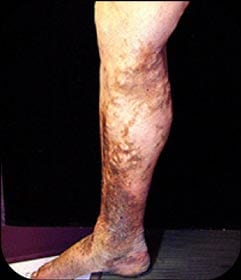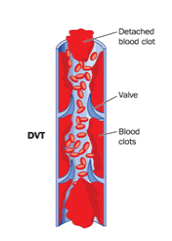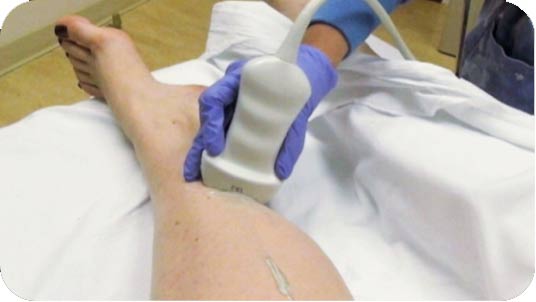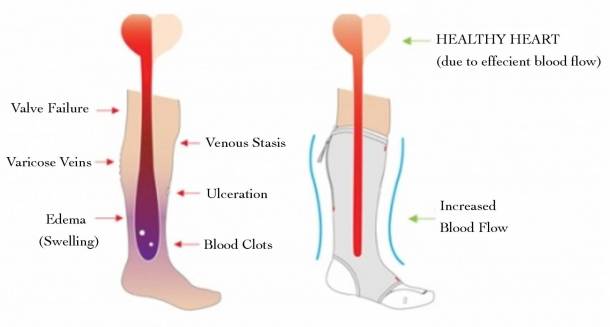
Virtual remote appointments are available. Contact us for a video telehealth evaluation.

All appointments conducted by our Board Certified doctor and not assistants or non-physician providers.
Deep Venous Thrombosis (DVT)
Deep Venous Thrombosis, or DVT, is a large blood clot that forms in one or more of the deep veins in your body. DVT usually happens in the legs or pelvis, but a clot can form anywhere in your body. Sometimes, part of the blood clot can break off and travel to your lungs.
Post-Thrombotic Syndrome (PTS)
Many DVT blood clots will be absorbed by your body over time with the help of blood thinners. During that course, however, the clot can cause permanent damage to the valves of the vein. Post-thrombotic syndrome (PTS) is a long-term complication of Deep venous thrombosis (DVT) resulting in swelling, pain, edema, venous ectasia, and skin induration limiting daily function. Mechanical thrombectomy, clot busters, angioplasty, and other methods by an experienced Interventional Radiologist may help reduce your risk of developing PTS. Similar minimally invasive treatments can also be applied to someone already suffering from PTS.

Risk factors for DVT
The following increase the risk of having a DVT:
- A personal or family history of having DVT
- Hormone therapy for birth control or to reduce postmenopausal symptoms
- Pregnancy and up to 6 weeks after childbirth
- Injury due to surgery, a broken bone, or other trauma
- Prolonged lack of movement due to hospitalization, illness, injury, paralysis, or lengthy travel
- Prior DVT
- Older age
- Chronic illness such as cancer
- Inherited blood disorders
- Obesity
- Smoking

Symptoms of DVT
Typical symptoms are pain, tenderness, and swelling of the calf which then becomes warm and red. There are other causes of a painful and swollen calf but an ultrasound test can be done to confirm the diagnosis of deep venous thrombosis (DVT).

TREATMENTS OPTIONS
The aims of treatment are:
- To prevent the clot spreading up the vein and getting larger.
- To reduce the risk of post-thrombotic syndrome developing.
- To prevent a further DVT in the future.
Blood thinners: Blood thinners are the most common treatment for DVT. They work by decreasing your blood’s ability to clot, which helps prevent an existing clot from getting bigger while your body slowly reabsorbs it.
Compression stockings: To help relieve leg pain and swelling, compression stockings maybe recommended after being diagnosed with DVT. They work by gently squeezing your legs to improve blood flow.

There are times, however, when more aggressive treatment is needed, such as when a DVT is very large, blocks major veins, or produces severe pain and swelling of the limb.A variety of minimally invasive treatments may help to relieve your DVT symptoms and reduce your risk for long-term complications such as post-thrombotic syndrome (PTS).
Mechanical thrombectomy devices are special catheters designed to help break up and physically remove all or portions of the blood clot during a minimally invasive procedure. A mechanical thrombectomy procedure can help to quickly restore blood flow, reduce the amount and duration of medications you have to take, and may help prevent damage to the valves in your vein, which can cause post-thrombotic syndrome (PTS). These procedures come with risks and aren’t right for everyone. Be sure to talk to your doctor to find out if they may be right for you.
IV Clot Busters are medications placed directly into the clot during a minimally invasive procedure. They are designed to quickly dissolve clots and restore blood flow.
Angioplasty procedure is where a catheter with a balloon at the tip is inserted into the vein containing the DVT and expanded in order to open up blood flow through the vein
Stenting procedure is where a catheter with a metal braided tube at its tip is inserted, and the stent is then expanded in the abnormal vein. The stent stays in place and acts as a scaffold to keep the vein open.
For people diagnosed with a DVT who are unable to take anticoagulation therapies, a filter may be placed into the inferior vena cava (IVC), which is the large vein that carries deoxygenated blood from the lower and middle body into the heart. The filter is used to catch blood clots that move from the lower body and prevent them from entering the lungs and causing a dangerous PE.
These maneuvers can be accomplished through minimally invasive techniques with small catheters as opposed to conventional, open surgical procedures. Usually, most patients can be treated in an outpatient setting with a tiny nick in the skin.
The above information explains what is involved and the possible risks. It is not meant to be a substitute for informed discussion between you and your doctor, but can act as a starting point for such a discussion.
